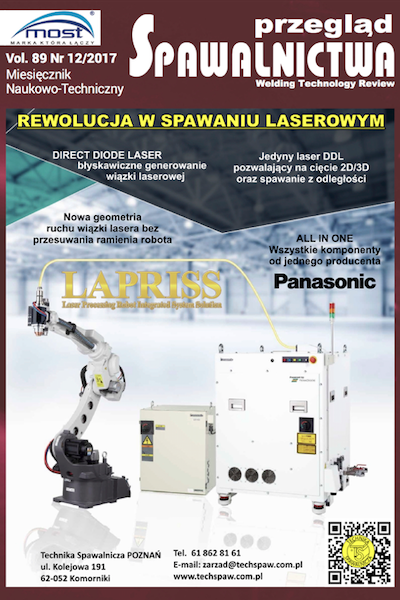Microstructure and properties of laser welded joints of 7CrMoVTiB10-10 steel
Main Article Content
Abstract
The paper presents results of the microstructure investigation, changes of chemical composition and hardness of the 7CrMoVTiB10-10 steel joints and their analyzes after heat treatment at 755 °C for 0.5 h, 1 h, 2 h. The joints were performed with a CO2 laser. Microstructural research where carried out using light and scanning electron microscopy. The energy dispersive spectroscopy was applied to specify distribution of chemical elements in the welded joints and revealed precipitates. Moreover the hardness tests were determined in order to define change of hardness at the cross-section of the joints. Investigation shown homogenous chemical composition in the welds. In the joints the precipitates rich in Ti, Mn, and V were revealed. Hardness of the weld amounted 400 HV1, but of HAZ 360 HV1. Heat treatment led to decreasing of the hardness of laser joints to about 270 HV1.
Downloads
Article Details
Creative Commons CC BY 4.0 https://creativecommons.org/licenses/by/4.0/
Welding Technology Review (WTR) articles are published open access under a CC BY licence (Creative Commons Attribution 4.0 International licence). The CC BY licence is the most open licence available and considered the industry 'gold standard' for open access; it is also preferred by many funders. This licence allows readers to copy and redistribute the material in any medium or format, and to alter, transform, or build upon the material, including for commercial use, providing the original author is credited.
References
Hernas A., Dobrzański J., Pasternak J., Fudali S.: Charakterystyki nowej generacji materiałów dla energetyki, Wydawnictwo Politechniki Śląskiej, Gliwice, 2015.
Pańcikiewicz K., Tasak E.: Charakter pękania połączeń spawanych stali 7CrMoVTiB10-10 (T24), Przegląd Spawalnictwa, vol. 85 (2), s. 36-39, 2013.
Golański G., Kępa J.: Nowoczesne stale dla energetyki charakterystyka, Wydawnictwo Politechniki Częstochowskiej, Częstochowa 2011.
Pańcikiewicz K., Kwiecień S., Tasak E.: Właściwości połączeń spawanych stali bainitycznej 7CrMoVTiB10-10, Przegląd Spawalnictwa, vol. 82 (10), s. 8-14, 2010.
Zieliński A., Golański G., Sroka M.: Influence of long-term ageing on the microstructure and mechanical properties of T24 steel, Materials Science and Engineering, vol. 682, s. 664-672, 2017.
Ziewiec A., Pańcikiewicz K., Tasak E.: Pękanie spoin w stali 7CrMo-
VTiB10-10 (T24) w czasie spawania, uruchamiania i eksploatacji bloków energetycznych, Przegląd Spawalnictwa, vol. 84 (5), s. 2-7, 2012.
Pańcikiewicz K., Zielińska-Lipiec A., Tasak E.: Mikrostruktura i właściwości mechaniczne złączy stali T24 spawanych metodami konwencjonalnymi i wysokoenergetycznymi, Przegląd Spawalnictwa, vol. 86 (4), s. 5-10, 2014.
Dimic A., Bakic G.M., Djukic M.B., Sijacki Zeravcic V., Ristivojevic M.: Characterization of welded joint made of T24 steel (7CrMoVTiB10-10) with and without post-weld heat treatment, 3rd IIW South-East European Welding Congress, Welding and Joining Technologies for a Sustainable Development and Environment, Timisoara, Romania, s. 185-189, 2015.
PN-EN 10216-2:2014-02. Rury stalowe bez szwu do zastosowań ciśnieniowych - Warunki techniczne dostawy - Część 2: Rury ze stali niestopowych i stopowych z określonymi własnościami w temperaturze podwyższonej.
Pańcikiewicz K., Zielińska-Lipiec A.: TEM investigations of the micro-structure of 7CrMoVTiB10-10 steel weld metal, Solid State Phenomena, vol. 231, s. 101-106, 2015.
Ziewiec A., Parzych S., Tasak E.: Skłonność do pęknięć zimnych stali bainitycznej stosowanej w podwyższonych temperaturach, Hutnik-Wiadomości Hutnicze, 78, s. 978-981, 2011.
